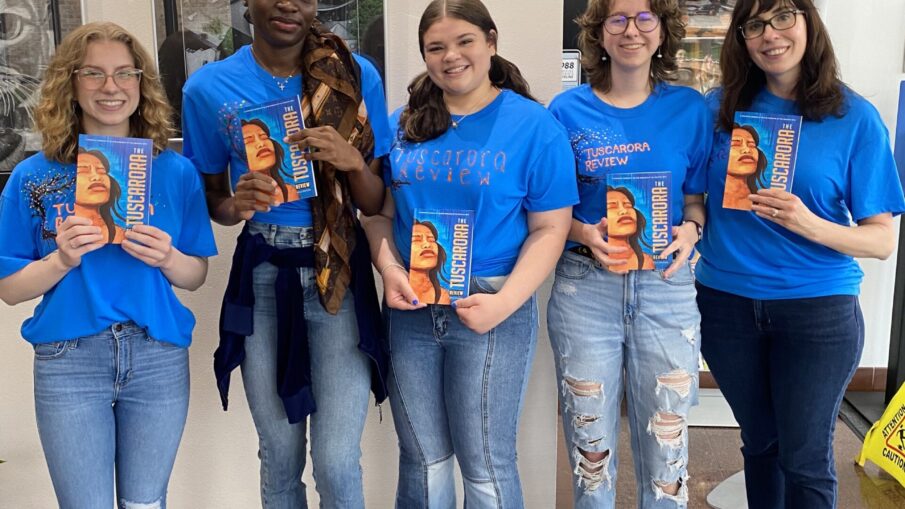For 45 years, Frederick Community College students have been given the chance to have their creative writing and artwork published in the Tuscarora Review.
To continue that tradition, the college’s literary magazine seeks entries for the next edition.
Current students, former students, faculty, and staff can submit written creative work and visual artwork. All submissions must be electronic, and one student can submit a max of five different entries with a different submission form for each. Any student can submit their work through https://www.frederick.edu/student submissions from now until Friday Jan. 10, 2025.
Tuscarora Review adviser Magin LaSov Gregg said she isn’t sure of the magazine’s origin.
“I hope it started as a way to provide a platform for students to showcase their creativity and share evidence of their learning in various disciplines across the humanities,” she said.
According to Gregg, the goal and priority of this magazine is to give students a creative outlet for any writing and visual artwork they have made. By publishing student-submitted work, the magazine sets out to share students’ talents among their peers, celebrate students’ willingness to express themselves and encourage a community within the college.
Not only does this magazine and its community try to create a safe environment for student self-expression, but according to Gregg it also sets out to help students boost their confidence, enhance their academic resume, and create connections with peers, faculty, and our wider community.
Students enrolled in ENGL222 (Creative Writing Practicum) are behind the Tuscarora Review; however, this class is only offered in the spring. According to Gregg, students who enroll in this English course, see it as a capstone (a high point) to their studies.
The only requirement for this class is to have already taken ENGL101. Enrolling in this class now for the spring 2025 semester would put students on the 2025 editorial board for the Tuscarora Review. Being on the editorial team entails: reviewing submission pieces, and ensuring the magazine is organized, visually appealing, cohesive, etc. Additionally, by being a part of the editorial board, going through the art selection process, and helping put together the magazine, students gain a more professional experience in terms of what it is like working on something like this.
“Being part of the editorial process also helps students learn about teamwork, editing, problem-solving, working across differences of perspective, and curating a cohesive body of work,” Gregg said. “Finally, being part of our editorial board is an excellent way for students to develop leadership skills, since all members of the board take on unique leadership roles.”
As the adviser of the Tuscarora Review, Gregg supports the editorial board throughout the lengthy process of putting the publication together. To her, this includes leading the editorial team in submission selection, giving feedback and reviews on the magazine’s format and design–aiding the overall creation process and being in contact with the printer. She also provides instruction to preserve a standard of excellence and sees to it that the publication stays faithful to its priorities in doing so.
“Overall, I see my role as empowering students to lead, and I want to provide lots of encouragement and support along the way, as well as a fun environment despite the deadline pressures we face,” she said.
Submitting to the Tuscarora Review does not guarantee being accepted. However, each piece that is submitted is reviewed carefully in an unbiased setting and is chosen based on: creativity, quality, composition, and general artistic caliber.
“It’s important to remember that the selection process is competitive, and we have a blind submission and review, meaning the editors do not know the names of authors until after their work is accepted or rejected.” Gregg said. “Our editors try to give feedback on rejected pieces when possible.”
Although not all pieces will be accepted, submissions are still encouraged. Pieces that are accepted into the final publication will also be eligible for awards.
Altogether, the process of putting the publication together can take up to six weeks. She described it as an iterative process” meaning it is a repetitive procession of changing and fixing until the print is perfected:
“The layout and design process can take up to six weeks, especially since it involves fine-tuning the arrangement of the content, selecting fonts, images, and ensuring everything is visually cohesive and sized appropriately, which is very important to print publications,” Gregg said. “Once the content is selected, we typically have to make adjustments to create a polished and professional final product in the design phase.”
This publication has time and effort–dedicated to ensuring a memorable outcome for not only the people who have submitted but those who read and work on the magazine.
“I would just like to emphasize that Tuscarora Review is more than just a publication—it’s a community,” Gregg said. “We encourage all students, whether they are writers, artists, or merely interested in getting supporting the creative process, to get involved. Whether you are submitting work, being part of the editorial board, just reading the magazine, or getting the word out, there is a place for everyone.”

